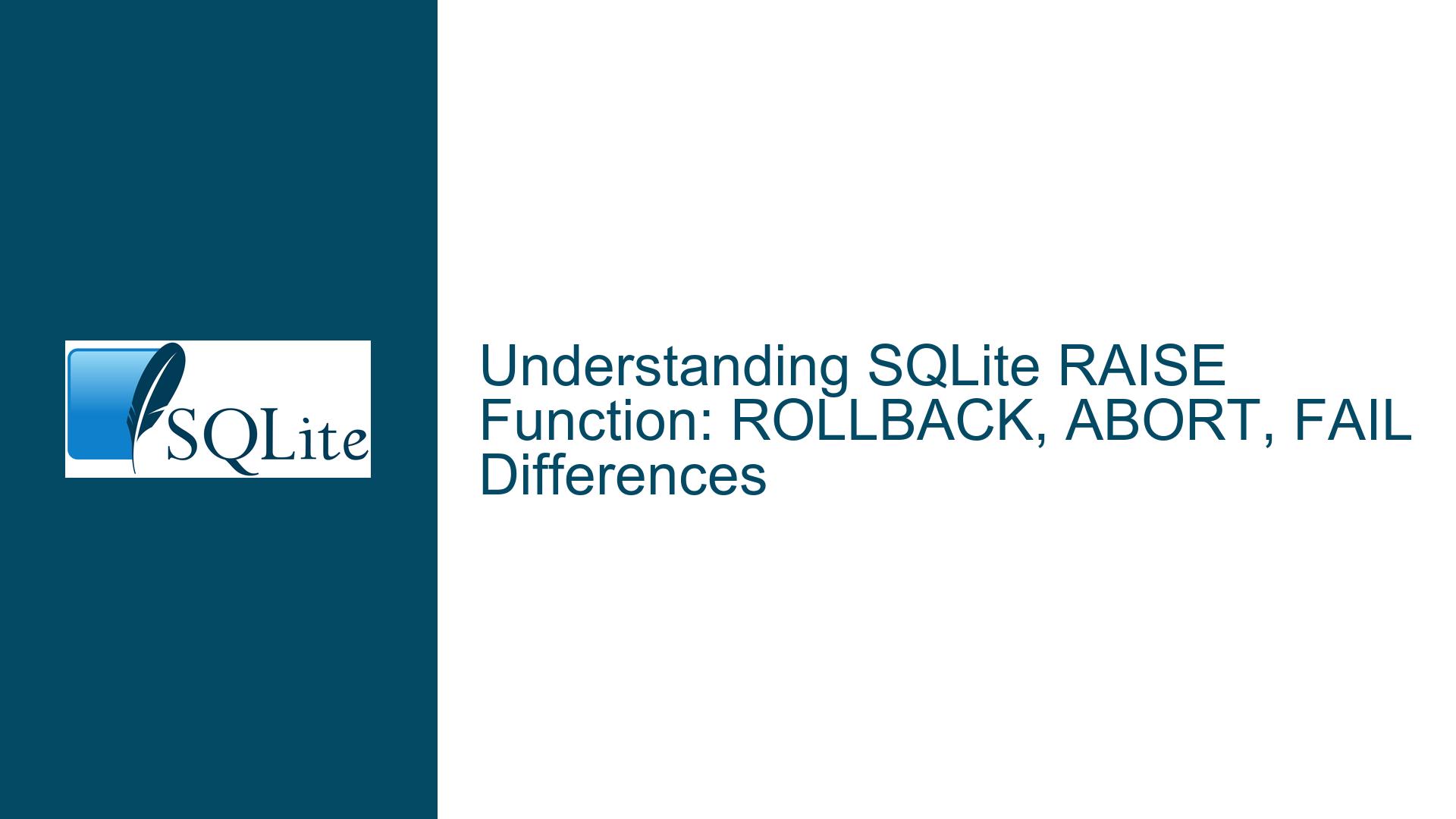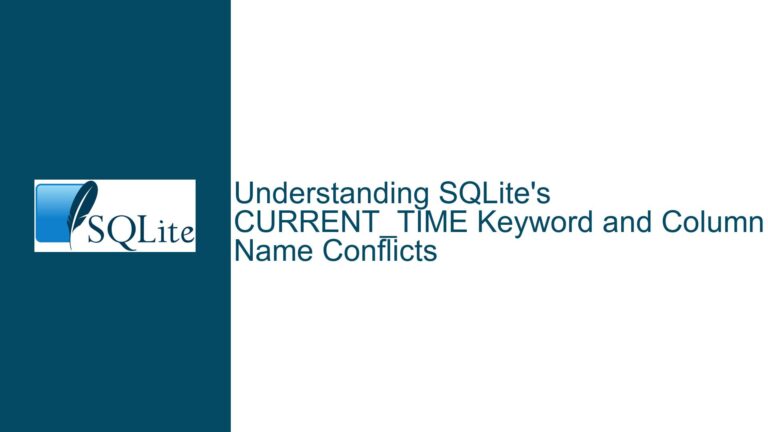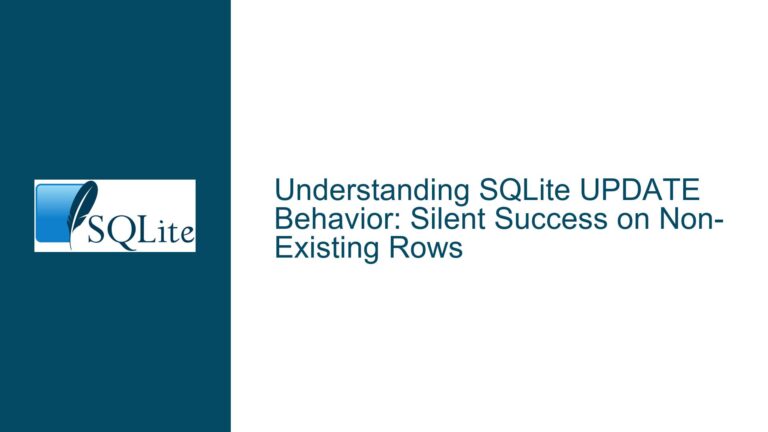SQLite RAISE Function: ROLLBACK, ABORT, FAIL Differences
RAISE Function Behavior in Transaction Contexts
The RAISE function in SQLite is a powerful tool for error handling and transaction control, but its behavior can be nuanced depending on the context in which it is used. Specifically, the ROLLBACK, ABORT, and FAIL options within the RAISE function each have distinct behaviors that can significantly impact the outcome of a transaction. Understanding these differences is crucial for effective database management and error handling.
When the RAISE function is invoked with the ROLLBACK option, it immediately terminates the current transaction and rolls back any changes made within that transaction. This is true even if the transaction is nested within another transaction. The ROLLBACK option is particularly useful when you want to ensure that a set of operations either completes entirely or not at all, maintaining the atomicity of the transaction.
The ABORT option, on the other hand, behaves differently. When RAISE(ABORT) is called, it aborts the current SQL statement but does not necessarily roll back the entire transaction. This means that any changes made by previous SQL statements within the same transaction will remain intact. However, the current statement that triggered the ABORT will not complete, and any changes it would have made are discarded. This can be useful in scenarios where you want to prevent a specific operation from completing without undoing the entire transaction.
The FAIL option is somewhat similar to ABORT but with a key difference. When RAISE(FAIL) is executed, it causes the current SQL statement to fail, but unlike ABORT, it does not roll back any changes made by the current statement up to the point of failure. This means that if the statement had already made some changes before encountering the FAIL, those changes will remain in effect. The FAIL option is typically used when you want to signal an error condition but do not want to undo any partial changes made by the statement.
It is important to note that the behavior of these options can be influenced by the presence or absence of explicit transaction control. In SQLite, if no explicit transaction is started using BEGIN, each SQL statement is automatically executed within its own transaction context. In such cases, the RAISE function’s behavior will be constrained to the scope of that single statement. However, when multiple statements are executed within an explicit transaction, the RAISE function’s behavior will affect the entire transaction, depending on the option used.
Impact of RAISE Options on Transaction Integrity
The choice between ROLLBACK, ABORT, and FAIL in the RAISE function can have significant implications for the integrity of your transactions. Each option affects the transaction in a different way, and understanding these impacts is essential for designing robust error handling mechanisms.
When RAISE(ROLLBACK) is used, the entire transaction is rolled back, ensuring that no partial changes are committed to the database. This is particularly important in scenarios where a set of operations must be atomic. For example, consider a banking application where a transfer of funds between two accounts involves multiple steps: debiting one account and crediting another. If any step fails, the entire transaction should be rolled back to maintain consistency. Using RAISE(ROLLBACK) in such cases ensures that either both operations succeed, or neither does, preserving the integrity of the data.
In contrast, RAISE(ABORT) only aborts the current SQL statement, leaving the rest of the transaction intact. This can be useful in situations where you want to allow partial completion of a transaction. For instance, in a batch processing scenario where multiple records are being inserted into a table, you might want to skip a problematic record without aborting the entire batch. By using RAISE(ABORT), you can ensure that the problematic record is not inserted, while allowing the rest of the batch to proceed.
RAISE(FAIL) offers a middle ground between ROLLBACK and ABORT. It allows the current SQL statement to fail without rolling back any changes made by that statement up to the point of failure. This can be useful in scenarios where partial changes are acceptable, but you still want to signal an error condition. For example, in a data import process, you might want to allow partial updates to a record while still logging an error for further investigation. RAISE(FAIL) allows you to do this without undoing the entire transaction.
The choice between these options should be guided by the specific requirements of your application and the nature of the operations being performed. In general, RAISE(ROLLBACK) should be used when atomicity is critical, RAISE(ABORT) when partial completion is acceptable, and RAISE(FAIL) when partial changes are acceptable but errors need to be signaled.
Best Practices for Using RAISE in SQLite Transactions
To effectively use the RAISE function in SQLite, it is important to follow best practices that ensure the integrity and consistency of your data. These practices include understanding the scope of each RAISE option, using explicit transaction control, and implementing robust error handling mechanisms.
First, always be aware of the scope of the RAISE function within your transactions. When using RAISE(ROLLBACK), remember that it will roll back the entire transaction, not just the current statement. This means that any changes made by previous statements within the same transaction will also be undone. If you only want to abort the current statement without affecting the rest of the transaction, use RAISE(ABORT) instead. Similarly, if you want to allow partial changes while still signaling an error, use RAISE(FAIL).
Second, use explicit transaction control to manage the scope of your transactions. By explicitly starting a transaction with BEGIN, you can ensure that all subsequent statements are executed within the same transaction context. This allows you to control the behavior of the RAISE function more precisely. For example, if you want to ensure that a set of operations is atomic, you can start an explicit transaction and use RAISE(ROLLBACK) to roll back the entire transaction if any operation fails.
Third, implement robust error handling mechanisms to manage the consequences of RAISE function calls. This includes logging errors, notifying users, and taking appropriate corrective actions. For example, if a RAISE(ABORT) is triggered, you might want to log the error and retry the operation, or skip the problematic record and continue processing the rest of the batch. Similarly, if a RAISE(FAIL) is triggered, you might want to log the error and allow the user to review and correct the data before retrying the operation.
Finally, consider the impact of nested transactions on the behavior of the RAISE function. In SQLite, nested transactions are not supported in the same way as in some other databases. Instead, each nested transaction is treated as a separate transaction context. This means that a RAISE(ROLLBACK) within a nested transaction will only roll back that specific transaction, not the outer transaction. To achieve the desired behavior, you may need to use savepoints or other mechanisms to manage nested transactions effectively.
By following these best practices, you can ensure that your use of the RAISE function in SQLite is both effective and efficient, maintaining the integrity and consistency of your data while providing robust error handling and transaction control.
Conclusion
The RAISE function in SQLite is a versatile tool for error handling and transaction control, but its behavior can be complex and nuanced. By understanding the differences between the ROLLBACK, ABORT, and FAIL options, and by following best practices for their use, you can ensure that your database operations are both robust and reliable. Whether you need to ensure atomicity, allow partial completion, or signal errors while allowing partial changes, the RAISE function provides the flexibility you need to manage your transactions effectively.






